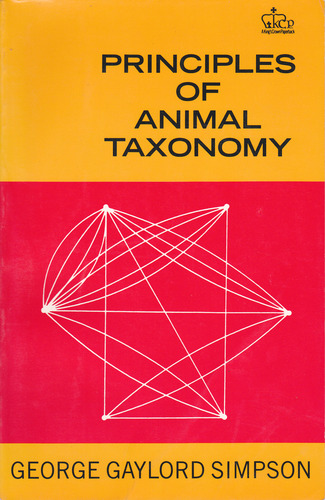Principles of animal taxonomy. George Gaylord Simpson

Principles.of.animal.taxonomy.pdf
ISBN: 023109650X,9780231096508 | 131 pages | 4 Mb

Principles of animal taxonomy George Gaylord Simpson
Publisher: Columbia University Press
Species conservation and systematics: the dilemma of subspecies. History Among the dynamics in play here, we can see the general and specific principle at work. Exclusive excerpt from Lord Robert May's book, Theoretical Ecology: Principles and Applications, published by Oxford University Press, 2007. [that] are designed to enable zoologists to arrive at names for taxa that are correct under particular taxonomic circumstances. New York: Columbia University Press. We evaluated completeness, accuracy, and historical trend of the taxonomic knowledge on the myrmecophilous ground beetle tribe Paussini (Coleoptera, Carabidae, Paussinae). Scarcely a decade ago, Simpson (1961) matter-of-factly concluded that for the protists "evolutionary classification is not yet practicable. Ithaca, NY: Cornell University Press. Homologues, natural kinds and the evolution of modularity. Excerpt from Theoretical Ecology: Principles and Applications. Principles of Animal Taxonomy (no.20). At all times, one of the key tasks of biology as a science was to establish the life form classification – systematics, taxonomy. Arthropods are the most diversified animal group [1, 2]. According to Simpson (“Principles of animal taxonomy”), a taxonomy is a “classification, including bases, principles, procedures and rules”. Fisheries, Poultry, Microbiology, Sericulture, Agriculture, Forestry, Diary Technology, Pharmacy, Veterinary Sciences, Food technology and Genetic engineering. Plant, animal and mineral systematics principles were stated by Karl Linney back in the 18th century. Biological systematics: principles and applications. Cuvier's The Animal Kingdom, Arranged According to its Organization, Serving as a Foundation for the Natural History of Animals, was an attempt to classify the animal kingdom on the basis of comparative anatomy, of which Cuvier's entire classification schema was Using these principles, Cuvier established a taxonomic approach based on comparative anatomy that established correlations between the inner systems that maintained life within an organism.
The Craft of Prolog pdf download
